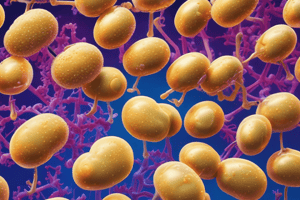Podcast
Questions and Answers
What is the characteristic of Staphylococcus aureus that allows it to inhibit complement activation and phagocytosis?
What is the characteristic of Staphylococcus aureus that allows it to inhibit complement activation and phagocytosis?
- Production of protein A (correct)
- Production of fibrin clot
- Production of exfoliative toxin
- Production of coagulase
Which of the following is NOT a common site of colonization by Staphylococcus aureus?
Which of the following is NOT a common site of colonization by Staphylococcus aureus?
- Ears
- Axilla
- Nares
- Small intestine (correct)
What is the mechanism of action of TSST-1 in toxic shock syndrome?
What is the mechanism of action of TSST-1 in toxic shock syndrome?
- Binding to MHC I and B-cell receptor
- Binding to MHC II and T-cell receptor (correct)
- Producing exfoliative toxin
- Inhibiting complement activation
What is the characteristic of Staphylococcal food poisoning?
What is the characteristic of Staphylococcal food poisoning?
What is the effect of cooking on Staphylococcal enterotoxin?
What is the effect of cooking on Staphylococcal enterotoxin?
Which gene is responsible for MRSA resistance by altering penicillin-binding proteins?
Which gene is responsible for MRSA resistance by altering penicillin-binding proteins?
What effect does Panton-Valentine leukocidin (PVL) have on leukocytes and tissues?
What effect does Panton-Valentine leukocidin (PVL) have on leukocytes and tissues?
Why is penicillin generally not used to treat MRSA infections?
Why is penicillin generally not used to treat MRSA infections?
Which of the following is NOT a recommended treatment option for MRSA infections?
Which of the following is NOT a recommended treatment option for MRSA infections?
What is a characteristic feature of MRSA that makes it a serious healthcare-associated infection?
What is a characteristic feature of MRSA that makes it a serious healthcare-associated infection?
Flashcards are hidden until you start studying
Study Notes
Staphylococcus aureus Characteristics
- Gram-Positive, β-hemolytic, catalase-Positive, coagulase-Positive cocci in clusters
- Ferments mannitol
- Produces coagulase and toxins
- Forms a fibrin clot around itself, leading to an abscess
Virulence Factors
- Protein A, binds Fc-IgG, inhibiting complement activation and phagocytosis
Common Sites of Colonization
- Naress, ears, axilla, and groin
Presentations
- Inflammatory disease:
- Localized infections: skin infections (impetigo, cellulitis, folliculitis, furuncles, carbuncles), organ abscesses, pneumonia, endocarditis, septic arthritis, and osteomyelitis
- Systemic infections: infective endocarditis, meningitis, osteomyelitis, septic arthritis
- Toxin-mediated disease:
- Toxic shock syndrome (due to TSST-1)
- Scalded skin syndrome (due to exfoliative toxin)
- Rapid-onset food poisoning (due to enterotoxins)
Toxic Shock Syndrome (TSS)
- Caused by TSST-1, a superantigen that binds to MHCII and T-cell receptor
- Results in polyclonal T-cell activation and cytokine release
- Associated with prolonged use of vaginal tampons, nasal packing, or trauma surgery
- Symptoms: fever, vomiting, diarrhea, rash, desquamation, shock, and end-organ failure
- Laboratory results: increased AST, increased ALT, increased bilirubin
Staphylococcal Food Poisoning
- Due to ingestion of preformed toxin
- Results in short incubation period (2-6 hours) followed by non-bloody diarrhea and emesis
- Enterotoxin is heat stable and not destroyed by cooking
Antibiotic Resistance
- MRSA (methicillin-resistant S aureus): important cause of serious healthcare-associated and community-acquired infections
- Resistance due to altered penicillin-binding proteins (conferred by mecA gene)
- Treatment: Vancomycin, Aminoglycoside (e.g., Gentamicin), Clindamycin, TMP/SMX (Cotrimoxazole or Bactrim), or Linezolid
Treatment Options
- For MSSA (Methicillin-sensitive S aureus): Methicillin, Nafacillin, Dicloxacillin, and Oxacillin
- For MRSA (methicillin-resistant S aureus): Vancomycin, Aminoglycoside (e.g., Gentamicin), Clindamycin, TMP/SMX (Cotrimoxazole or Bactrim), or Linezolid
Studying That Suits You
Use AI to generate personalized quizzes and flashcards to suit your learning preferences.




